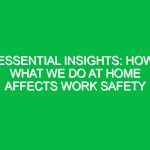“`html
Essential Insights: How We React to Our World for Better Safety
Introduction
Good morning team! Today, we are going to explore a crucial aspect of our daily operations—how we react to our world for better safety. Our ability to respond effectively to various situations can significantly impact our overall safety at work. Understanding this concept not only helps in preventing accidents but also fosters a culture of safety throughout our organization.
Why is this topic important? Because safety is a collective responsibility. Each of us plays a vital role in maintaining a safe work Environment. By enhancing our awareness and reactions to potential Hazards, we can protect ourselves and our colleagues from harm.
Understanding How We React to Our World
When we talk about how we react to our world, we refer to our responses to various stimuli, including environmental conditions, equipment, and even our fellow workers. The importance of this lies in our ability to stay alert and make informed decisions in potentially hazardous situations.
Our reactions can be influenced by Training, past experiences, and even stress levels. It’s essential to acknowledge that many misconceptions surround safety reactions. For instance, some employees believe that Safety Measures are merely suggestions rather than mandatory practices. This misunderstanding can lead to negligence and, ultimately, accidents.
Key Hazards, Risks, and Safety Considerations
Understanding the hazards associated with our reactions to the workplace is vital. Here are some specific risks we must consider:
- Environmental Hazards: Weather conditions, slippery surfaces, and poor lighting can all affect how we react. For example, icy walkways can lead to slips and falls if we do not adjust our walking pace.
- Equipment Hazards: Machinery must be operated correctly. Misreading equipment signals or ignoring warning signs can lead to severe injuries.
- Interpersonal Risks: In high-stress situations, miscommunication among team members can escalate risks. It’s crucial to maintain clear communication to prevent accidents.
Ignoring safety protocols can have real-world consequences. For instance, a slip and fall accident can lead to lost workdays, increased insurance costs, and a decline in workplace morale. Therefore, being proactive in our reactions is essential.
Best Practices, Procedures, & Actionable Advice
To enhance our reactions to the world around us, we must adopt Best Practices. Here are some actionable steps:
- Stay Alert: Always be aware of your surroundings. If you notice a hazard, report it immediately.
- Follow Safety Procedures: Familiarize yourself with the safety protocols specific to your role. Consistency in following these procedures is key.
- Practice Good Communication: If you see something unsafe, say something. Encourage your colleagues to do the same.
Consider the following real-life incident: Last year, a worker failed to notice a wet floor sign and slipped, resulting in an injury. The incident could have been avoided if the worker had reacted to the environmental cues around them. This serves as a reminder of how important it is to stay vigilant.
Regulations, Standards, and Compliance
Adhering to safety Regulations is not just a best practice; it’s a legal requirement. Familiarize yourself with relevant Standards such as OSHA guidelines and your company’s safety policies. Understanding these regulations helps us stay compliant and protects our rights as employees.
Why is compliance critical? It ensures that we are all working within a safe environment. When we follow established safety protocols, we not only protect ourselves but also our colleagues, and we contribute to a culture of safety that Benefits everyone.
Employee Engagement & Discussion
Now, I’d like to open the floor for discussion. Here are a few questions to consider:
- What safety challenges have you encountered related to your reactions to workplace hazards?
- Can you share a time when being aware of your surroundings prevented an accident?
- What additional training or resources would help you feel more prepared to react in hazardous situations?
Your insights are invaluable! Engaging in these discussions not only helps us learn from each other but also strengthens our safety culture.
Conclusion & Key Takeaways
In summary, understanding how we react to our world is essential for maintaining safety in the workplace. By being aware of hazards, following safety procedures, and engaging in open communication, we can significantly reduce risks and protect ourselves and our colleagues.
Let’s remember that safety is a shared responsibility. Each of us has a role in creating a safe working environment. Thank you for your attention today, and let’s commit to prioritizing safety in everything we do!
“`


